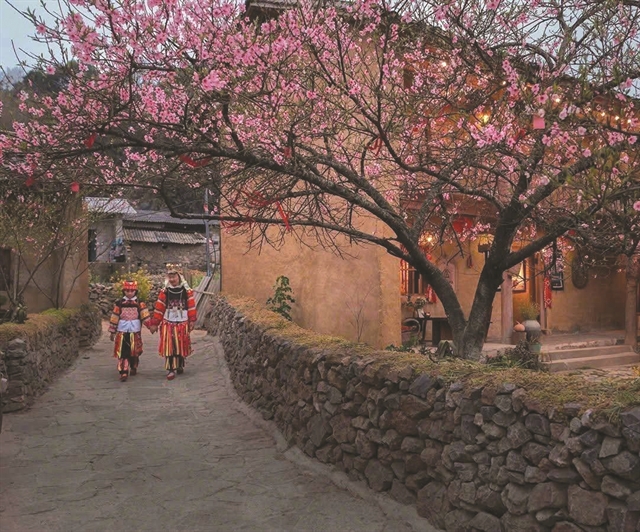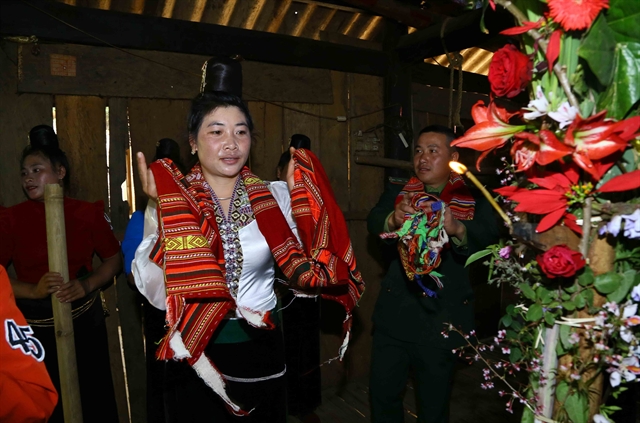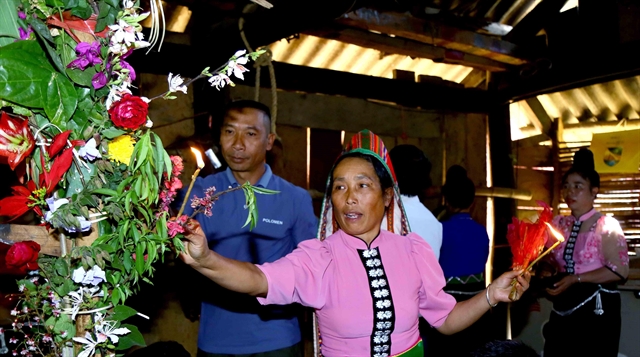 Life & Style
Life & Style

Sà Típ Festival begins with the ritual offering, which is then followed by the activities of drinking rice wine, enjoying the feast and dancing to the rhythms of the drums and gongs. The celebration often lasts until the next morning. Villagers return home filled with joy, and some continue to attend the festivals at other households within the community the following days.

|
| Villagers enjoy rượu cần (wine stored in a big jar and drunk with long bamboo straws) during Sà Típ Festival. VNA/VNS Photos Quang Quyết |
SƠN LA Every spring after the Lunar New Year Festival, when the ban (Bauhinia) flowers dot the hills with white blooms and the bitter bamboo shoots grow abundantly in the forest, the Xinh Mun ethnic group in Phiêng Pằn Commune in the northern province of Sơn La celebrate Sà Típ Festival.
During their traditional festival, Xinh Mun people pray for the well-being of everyone in their families and for bumper crops in the new year.

|
| A Xinh Mun woman performs the xòe dance during Sà Típ Festival. |
According to Vì Văn Lếch, Vice Chairman of the People's Committee of Phiêng Pằn Commune, Xinh Mun people live in 12 out of the 19 villages in the locality. Many of their traditional customs and traditions are still well preserved, including the Sà Típ Festival that is organised by the community once a year before the new rice planting season.
This year, 10 Xinh Mun households in Phiêng Khàng village in Phiêng Pằn celebrate the festival from the end of February till the beginning of April. As revealed by the deputy head of the village, Vì Văn Hiên, the Sà Típ Festival is sequentially held in each household with the participation of the local shamans.
In the past, the ceremony lasted for five days and involved various rituals, including the slaughter of livestock and poultry. After the rituals, the villagers would gather for a five-day and five-night celebration. Nowadays, the ceremony is simplified and organised within two to three days.
After a good day is selected, the host invites other villagers to come to celebrate the festival together with their family. A bamboo is cut to make a nêu pole, which is decorated with sugarcane, forest leaves, white ban flowers and golden sticky rice harvested from the previous harvest season.
Around the pole, they set up a jar of traditional rice wine and traditional musical instruments. Meanwhile, the women prepare a feast for the ceremonial offering.

|
| An offering tray to pray for luck and bumper crops in the new year. |
The ceremonial feast includes two boiled chickens, freshly steamed sticky rice, bánh chưng (square sticky rice cake), pumpkin, bitter bamboo shoots and rice wine.
Sà Típ Festival begins with the ritual offering, which is then followed by the activities of drinking rice wine, enjoying the feast and dancing to the rhythms of the drums and gongs. The celebration often lasts until the next morning. Villagers return home filled with joy, and some continue to attend the festivals at other households within the community the following days.

|
| The Sà Típ festival is sequentially held in each household with the participation of the local shamans. |
Villager Vì Văn Liên said: “The festive atmosphere brings excitement and uplifts the spirits of our community before embarking on a new planting season.
“The Sà Típ Festival has played a significant role in enhancing the unity of the community, motivating us to actively work for a prosperous and happy life. Additionally, it showcases the unique spiritual culture of the Xinh Mun ethnic community, contributing to preserving and promoting the cultural values of the various ethnic groups in Sơn La Province.” VNS

|
| Villagers are welcomed by the host during Sà Típ Festival. |